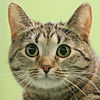Don Sphynx
| Don Sphynx | |
|---|---|
| Default: | |
| Shoulder height | |
| length | |
| Weight | Male: 4–6 kg. Cat: 3.5–4.5 kg |
| allowed colors | all |
| colors not allowed | no |
| permitted coat drawing | all |
| List of cat breeds | |
The Don Sphynx , also known as Don Hairless or Donskoy , is a hairless breed of cats of Russian origin and is therefore one of the so-called naked cats . The breed is not related to the better known Canadian Sphynx . Your hairlessness is caused not by a recessive , but by a semi-dominant gene .
Character and appearance
The Don Sphynx are said to be affectionate and cuddly animals that need a lot of attention. Like all Sphynx cat breeds, they are considered to be balanced and active.
In the pedigree cat association standards, the Don Sphynx is described as a medium-sized, muscular cat, with large ears, almond-shaped eyes, and long toes that look like monkey fingers. The skin is bare or covered with a light fluff. Don Sphynx cats come in five fur variants with a hair length of up to 3 millimeters. If the downy is light, the cats are called "velor", and if the hair is thicker they are called "brush". Whiskers are desirable and usually present.
origin
The ancestor of Don Sphynx was discovered in the city of Rostov-on-Don in 1986 by the Russian Elena Kovaleva. It was a female cat named Varvara, or Varja for short . This cat gave birth to offspring with sparse fur, which in turn had hairless offspring after being mated back. Speculations that the Don Sphynx's genetic disposition could be traced back to the Chernobyl nuclear accident belong in the realm of the imagination. The Don Sphynx was first recognized by the WCF in 1997 and as a Donskoy by the TICA in 2005 .
Legal situation
The breed of Don Sphynx is in Germany - like the other Sphynx races - as torture breeding if the whiskers are missing. The systems of the whiskers are basically present in the cats. However, these often break off after a few millimeters. In order to prevent breeding, the competent authority can pronounce a breeding ban in individual cases and order the sterility of the animal concerned, provided that the animal welfare requirements are met. However, there is no general, blanket breeding ban on hairless cats.
Related breeds
The Peterbald was originally bred by crossing the Don Sphynx with Siamese and Orientals to get hairless cats of the oriental type. Today crosses between Don Sphynx and Peterbald are no longer allowed.
The breed Sphynx , also called Canadian Sphynx, comes from Canada . In this cat, another gene (inherited in a recessive manner) is responsible for the hairlessness. All three Sphynx species are physically different and have different breed characteristics. Therefore, they should not be crossed with each other.
Individual evidence
- ↑ a b c d Skupine: S phyn x. The naked truth. 2013.
- ↑ a b Marcus Skupin: Hairless Felids. Origin - races - attitude (= world of cats. 6). Books on Demand, Norderstedt 2017, ISBN 978-3-8482-2449-4 .
- ↑ Don Sphynx Breed Portrait ( Memento of the original from January 30, 2014 in the Internet Archive ) Info: The archive link was inserted automatically and has not yet been checked. Please check the original and archive link according to the instructions and then remove this notice.
- ↑ Don Sphynx Breed Portrait ( Memento of the original from January 30, 2014 in the Internet Archive ) Info: The archive link was inserted automatically and has not yet been checked. Please check the original and archive link according to the instructions and then remove this notice.
- ↑ Expert opinion on the interpretation of Section 11b of the Animal Welfare Act (prohibition of torture breeding). (PDF; 8.8 MB) Expert group, animal welfare and pet breeding, accessed on February 24, 2016 .
- ↑ Administrative Court Berlin: Breeding naked cats without whiskers is torture breeding. In: VG 24 K 202.14. September 23, 2015, accessed on September 24, 2015 (German): “ According to the Animal Welfare Act, it is forbidden to breed vertebrates if they lack body parts for appropriate use or if they are unsuitable and cause pain, suffering or damage as a result. To avoid breeding, the competent authority can order the sterility of vertebrates. The veterinary and food supervisory office of the district office Spandau forbade the plaintiff from breeding on this basis and asked her to castrate the tomcat "Willi" she was keeping. "
Web links
- Breed portrait Don Sphynx Swiss cat magazine 01/14


